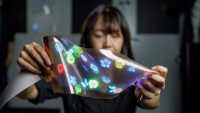LG Display Reveals Stretchable Prototype That Folds, Twists
November 14, 2022
LG Display has unveiled a stretchable display form factor it says surpasses existing foldable and rollable technology. Based on a highly resilient film-type substrate made of silicon used in contact lenses, LG’s 12-inch prototype stretches to up to 14 inches. The stretchable display uses a MicroLED light source with full-color RGB and resolution of 100ppi that LG says “competes with most existing monitors.” It’s spring-wired frame gives it the durability to withstand repetitive changes to form as well as significant external impact, LG adds, describing a consistency “similar to that of a rubber band.”
The display can be “stretched, folded or twisted,” and extended by up to 20 percent in any direction, LG says in its press release. Stretchable displays are not only thin and light, but are also “easily attachable to curved surfaces such as skin, clothing, furniture, automobiles and aircraft.”

In the future, LG envisions the stretchable displays to be widely used in industries such as wearables, mobility, smart devices, gaming and fashion. LG didn’t share information about any specific upcoming products featuring the displays.
LG has been working alongside 20 organizations in South Korea’s industrial and academic sectors as part of a government project to create next-generation display technology, with a goal of completion by 2024. Soo-young Yoon, executive VP and CTO at LG Display, says the ongoing effort shows LG “continuing to lead the industry’s paradigm shift.”
But Digital Trends notes that while LG Display “creates many of the new technologies that ultimately end up in products we can buy from companies like LG Electronics, Sony, and Vizio,” which use its OLED panels, for the moment “there seems to be limited interest in LG Display’s more exotic technologies, like rollable OLED. Only LG Electronics itself has brought a rollable OLED TV to market, but it’s prohibitively expensive at $90,000.”
Gizmodo imagines it playing a role in “a future of shatter-proof gadgets,” and says “remember when BMW wrapped an SUV in color-changing, black and white E Ink screens earlier this year? Imagine that car instead becoming a rolling animated billboard at night.”
When pixel density improves, the contact lens-friendly material could also potentially be used to display mixed reality without a headset.
The Verge writes that “LG Display isn’t the only company exploring stretchable displays. Samsung has previously showcased the viability of the tech in real-world applications after creating a stretchable OLED screen in a prototype heart rate monitor back in June 2021.”

No Comments Yet
You can be the first to comment!
Sorry, comments for this entry are closed at this time.